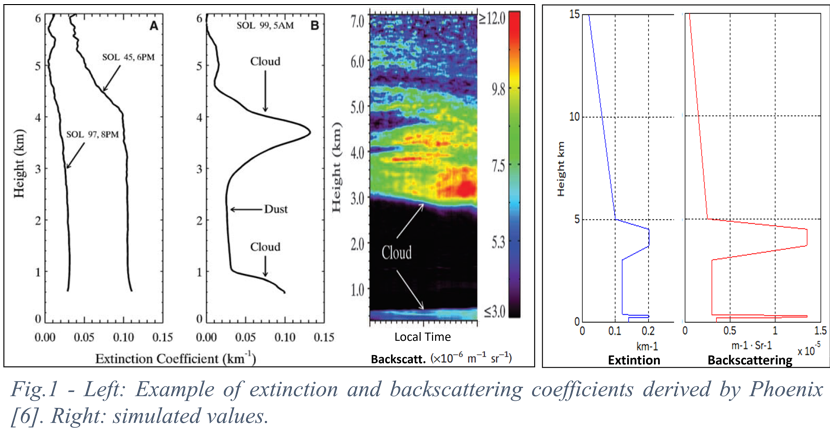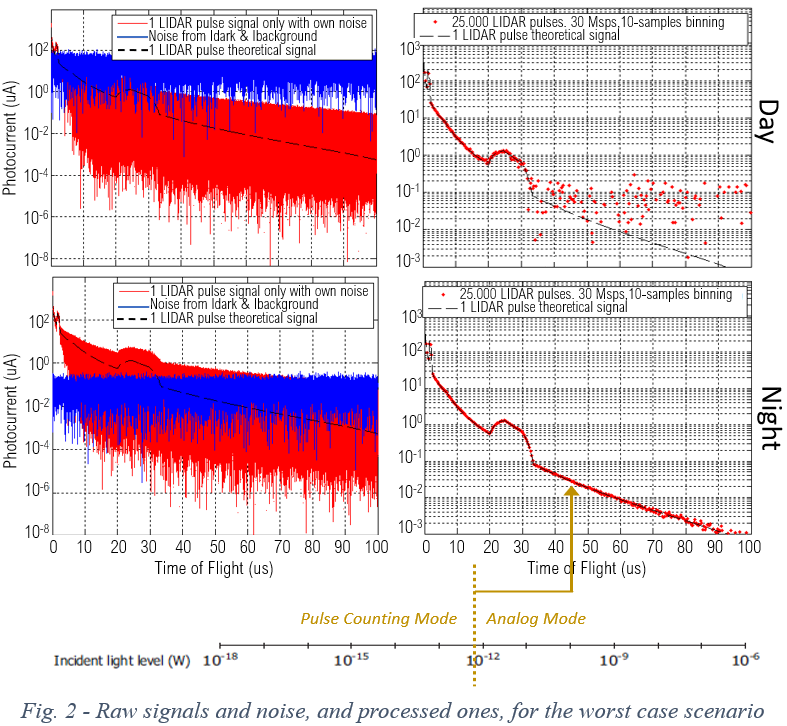Miniature LIDAR for Mars Exploration
- 1Instituto Nacional de Técnica Aeroespacial - INTA, Spain
- 2York University, Canada
- 3Politecnico di Milano, Italy
- 4The Nanomaterials and Nanotechnology Research Centre (CINN), Spain
- 5Asphericon, Germany
The composition of the Martian atmosphere and its dust content is a key factor for understanding the climate of the Red Planet, which is of vital importance to enable future human exploration. The use of atmospheric LIDARs to characterize densities and sizes of aerosol with a height profile, is commonly used on Earth. However, Earth LIDARs are heavy and very power-demanding, which make them not easily on-boardable for planetary exploration.
We propose the development of a compact LIDAR aimed at providing the most precise characterization of the suspended dust and clouds of the atmosphere of Mars to-date, while maintaining very reduced power, mass and volume envelops to facilitate its accommodation in a wide variety of landed assets.
Rationale and heritage
In the past years, INTA has developed four miniature radiometers for different missions: MetSIS for MetNet Lander [1], DREAMS-SIS for Schiaparelli [2], SIS’20 for Kazachok [3] and RDS for Perseverance [4]. All of them, at different levels depending on their complexity, allow the estimation of the atmospheric optical depth with high time resolution, detection of clouds and estimation of the dust concentration vertical profile. A natural step forward to complement our capabilities, especially for the dust profile and characterization of clouds, is a LIDAR.
There is only one LIDAR that has already operated on Mars, on board the Phoenix mission. With a 2-wavelengths configuration at 532 and 1064 nm but without depolarization, it operated in the North Pole of Mars for 90 sols [5]. The laser pulses had a power of 30-40 kW and duration of 10 ns. Total mass was 6 kg and the power consumption 30W.
A '2B+1d' LIDAR configuration is proposed here to obtain the Particle Backscatter Coefficient (PBC) at two wavelengths (2B), and the depolarization ratio at one of them (1d). They both are used to obtain three LIDAR parameters relevant for dust and cloud characterization: the particle linear depolarization ratio (PLDR), the lidar ratio (LR), and the colour ratio (CR). The intended range is set around 20 km, depending on the scenario, and depolarization measurement capability shall be incorporated.
Key technologies for miniaturization
The target mass and power envelop are <4 kg and <15W, respectively. The instrument should be capable of operating at atmospheric temperatures below -100°C to minimize the requirements for its accommodation. Achieving those goals will be a technological challenge, and it will be necessary to use technologies not employed before in this scenario. Several key aspects are identified:
- Pulsed semiconductor laser diodes are proposed for the transmitter, instead of usual (and bulkier) diode-pumped, Q-switched solid-state lasers. This reduces the emitted energy and in turn requires higher repetition rates to improve the Signal-to-Noise ratio.
- Silicon Photomultipliers, also known as Multi Pixel Photon Counters, will be used as detectors. They allow lower biasing voltages than other high-gain technologies, while they show some trade-offs such as their so-called "cross talk" noise. Its performance under the applicable thermal and radiation environments must be addressed.
- The use of new synthesis methods to obtain very low thermal expansion coefficient (CTE) materials (crystalline β- eucryptite) to reduce the thermal requirements related to structure and alignment.
- To reduce the size of the optics and to mitigate the complexity of the collimation of a semiconductor laser (with large spots and emission apertures), 'free form' optics will be considered in the optical design.
- From the signal processing point of view, the aim is to design a receiver that autonomously adapts the measurement mode (analogue or pulse counting) and parameters (e.g., variable time intervals for pulse-counting) in real time, providing the best signal quality vs. vertical resolution compromise for each altitude.
Feasibility
To preliminarily assess the feasibility of this LIDAR to reach a scientifically meaningful range, we have performed several simulations of the expected signal and signal-to-noise ratio using extinction and backscattering profiles representative of different dust conditions on Mars, together with technical data extracted from the datasheets of real pre-selected parts and opto-mechanical parameters values that we consider feasible for a compact instrument as the intended one. Emitted pulses have a power of 600W and a duration of 150ns. We have simulated three different background illumination scenarios: night, twilight, and midmorning, as this is critical from the point of view of the “offset” signal it generates (that must be filtered out) and the noise associated with it. We employed worst-case (high) diffuse radiance values on Mars. Extinction and backscattering coefficients have been extracted from Phoenix LIDAR measurements [6], and background illumination values from RDS measurements in Perseverance.


The conclusion is that, with adequate signal processing, we should be capable of reaching 4 km during the day, 6-7 at twilight and 15 at night, for the worst-case scenario. 20 km are feasible in better scenarios.
On-going activity and next steps
A breadboard prototype of the system is being built at INTA for only one channel (one wavelength; no polarization) based on pre-selected pulsed laser diode and silicon photomultiplier, with standard off-the-shelf optical parts and filters. Preliminary laboratory and outdoor measurements will be done to validate the simulations and confirm the feasibility of reaching a meaningful range with the strict miniaturization constraints.
Low-temperature characterization of the emitters and detectors, as well as Displacement Damage tests to assess their robustness to the radiation environment will be done by the end of the year. The electronic design has a large heritage from previous Martian sensors as the ones mentioned above, all of them designed to operate down to -130ºC with no heating. Next steps will include thermal cycling testing of the optics and the support materials and feasibility analysis of the optomechanical frame to face such conditions.
[1] Ari-Matti Harri et al., Geosci. Instrum. Method. Data Syst., 6, 103–124, 2017.
[2] I. Arruego et al., Advances in Space Research 60 (2017) 103–120.
[3] I. Arruego, Proc. IPPW 2018.
[4] V. Apéstigue et al., Sensors 2022, 22, 2907
[5] J. A. Whiteway et al., Journal Geophys. Res., Vol. 113, E00A08.
[6] J. A. Whiteway, et al., Science 325, 68 (2009).
How to cite: Arruego, I., Jiménez, J. J., Martín-Ortega, A., García, E., Rivas, J., Carrasco, I., Vázquez, G., Córdoba-Jabonero, C., Gómez, L., Toledo, D., Belenguer, T., González, L. M., Moya, A., Whiteway, J. A., Daly, M. G., Scaccabarozzi, D., Saggin, B., Fernández-Valdés, A., Heckl, A., and Fuchs, U.: Miniature LIDAR for Mars Exploration, Europlanet Science Congress 2022, Granada, Spain, 18–23 Sep 2022, EPSC2022-835, https://doi.org/10.5194/epsc2022-835, 2022.

